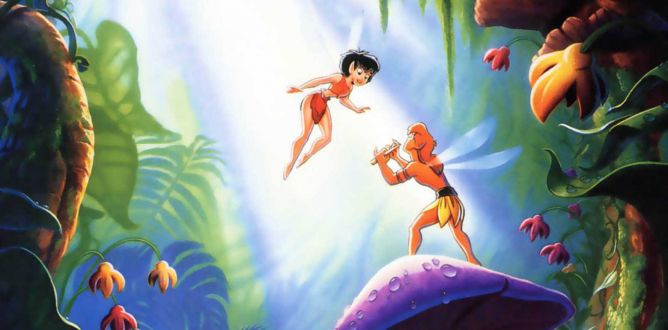FernGully: The Last Rainforest Parent Guide
A harmless environmental animated feature with a Saturday morning cartoon aesthetic.
Parent Movie Review
The fairies of FernGully live in an enchanted world. Hexxus (voiced by Tim Curry), the spirit of destruction, has long been imprisoned within a tree by Magi Lune (voiced by Grace Zabriskie) so the fairies live in peace and harmony with nature, using their magical powers to help things grow. In fact, life is so good that Magi’s young apprentice, Crysta (voiced by Samantha Mathis), doesn’t understand why she needs to study the past and learn to control her magic. That is, until Crysta’s world changes…
Flying with her friends, Crysta soars above the tree canopy and sees a distant mountain and dark smoke, which fills her with curiosity about the world beyond the rainforest. Then a badly damaged bat (voiced by Robin Williams) flies into the forest. Having escaped from a laboratory, Batty has terrifying stories of the experiments conducted on him by humans, who the fairies believe had died out. And then loggers enter the forest. When Crysta shrinks a logger (voiced by Jonathan Ward) down to fairy size to save him from a potentially fatal accident, she learns more than she ever bargained for about the wider world. Now she must draw upon all her power to save her forest from Hexxus and humans.
FernGully: The Last Rainforest doesn’t hold any surprises for viewers over the age of eight. But it’s a harmless film with no content issues aside from the very minor violence and peril necessary to drive the plot. Only the most sensitive of children will be troubled by this movie. Parents watching this production will likely be bored and frustrated that the movie doesn’t live up to the talents of its voice cast – Robin Williams and Tim Curry are certainly higher rated talent than one would expect in a production that feels like an extended Saturday morning cartoon.
Production values aside, FernGully: The Last Rainforest provides young viewers with valuable messages about working together and cherishing the natural world. The fairies sing “There’s a simple harmony to life – a magical thing.” Although better visual design would have added more punch to this message, the film celebrates the beauty of nature and encourages viewers to treasure and care for their planet, and particularly its forests.
Directed by Bill Kroyer. Starring Samantha Mattis, Christian Slater, Robin Williams, Tim Curry. Running time: 76 minutes. Theatrical release April 10, 1992. Updated March 28, 2019Watch the trailer for FernGully: The Last Rainforest
FernGully: The Last Rainforest
Rating & Content Info
Why is FernGully: The Last Rainforest rated G? FernGully: The Last Rainforest is rated G by the MPAA
Violence: A character discusses experiments on animals. A violent character is imprisoned within a tree – twice. A bat repeatedly flies into trees. A man is trapped in a spider’s web and is almost pushed into a giant saw. An individual waves a knife around – she doesn’t know what it is, but her actions frighten another character. A character falls from a tree. A reptile sings a song about eating another character. It eats the man and then spits him out. There are potentially frightening images of the villain as he sometimes appears skeletal or filled with flame. A character dissolves into sparkles and air.
Sexual Content: A couple kiss. Fairies wear skimpy costumes.
Profanity: None.
Alcohol / Drug Use: None.
Page last updated March 28, 2019
FernGully: The Last Rainforest Parents' Guide
Why are trees and forests so important to the health of our planet? What can you do to protect our forests? What can you do to plant more trees?
Loved this movie? Try these books…
The Lorax, by Dr. Seuss, is a great book for helping children see the importance of protecting nature.
Because of an Acorn, written by Lola M and Adam Schaefer, uses lovely illustrations to tell the story of an acorn and the interconnected layers of the ecosystem.
Seeds of Change: Wangari’s Gift to the World tells the story of a young woman in Kenya and her passionate love of the land. Using her scientific education, Wangari uses her knowledge to inspire women to plant more trees, improving their environment and leading to a Novel Peace Prize. Written by Jen Cullerton Johnson and illustrated by Sonia Lynn Sadler, this book can inspire kids to be the change they want to see. (This story is also told by Jeanette Winter in Wangari’s Trees of Peace, by Franck Prevot in Wangari Maathai The Woman Who Planted Millions of Trees, and by Claire E Nivola in Planting the Trees of Kenya The Story of Wangari Maathai.)
Children who love flowers will enjoy the true story of Alice Rumphius, who scattered lupine seeds along the cost of Maine, creating a natural legacy. Caldecott winner, Miss Rumphius, written by Barbara Cooney, tells Alice’s story with beautiful illustrations.
In a dreamy picture book for young children, Land Wilson and Sue Cornelison invite readers to cherish the earth. Sophia’s Dream takes children on a trip to the moon where they can look down at their beautiful blue planet.
Home Video
The most recent home video release of FernGully: The Last Rainforest movie is February 19, 2002. Here are some details…
Related home video titles:
“I am the Lorax. I speak for the trees.” Dr. Seuss’ The Lorax” is the granddaddy of environmental stories for kids – this one told in stunning computer animation.
Once Upon a Forest is another animated story in an arboreal setting; this one features animals making a dangerous trek through the woods in search of a healing herb.
Nature is amazing even in the harshest of environments. March of the Penguins is a documentary about the migration of Emperor Penguins in Antarctica. A more lighthearted, animated penguin story is told in Happy Feet.

